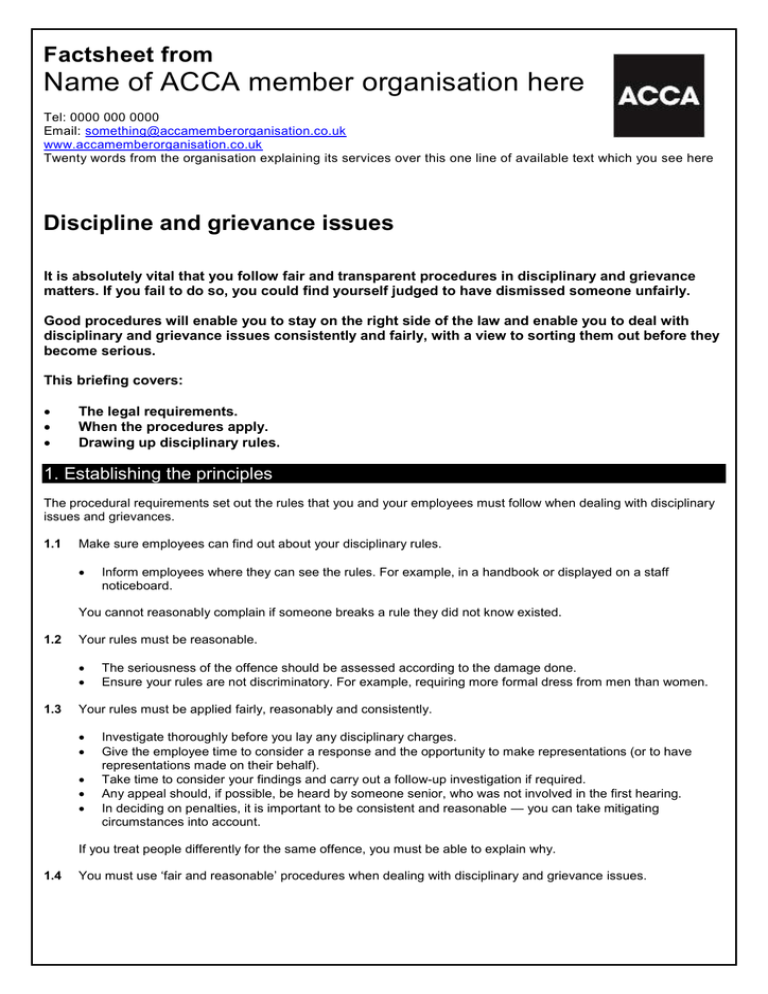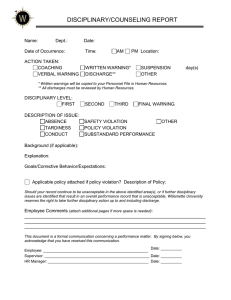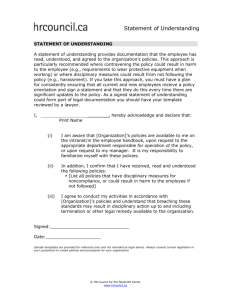
Factsheet from
Name of ACCA member organisation here
Tel: 0000 000 0000
Email: something@accamemberorganisation.co.uk
www.accamemberorganisation.co.uk
Twenty words from the organisation explaining its services over this one line of available text which you see here
Discipline and grievance issues
It is absolutely vital that you follow fair and transparent procedures in disciplinary and grievance
matters. If you fail to do so, you could find yourself judged to have dismissed someone unfairly.
Good procedures will enable you to stay on the right side of the law and enable you to deal with
disciplinary and grievance issues consistently and fairly, with a view to sorting them out before they
become serious.
This briefing covers:
The legal requirements.
When the procedures apply.
Drawing up disciplinary rules.
1. Establishing the principles
The procedural requirements set out the rules that you and your employees must follow when dealing with disciplinary
issues and grievances.
1.1
Make sure employees can find out about your disciplinary rules.
Inform employees where they can see the rules. For example, in a handbook or displayed on a staff
noticeboard.
You cannot reasonably complain if someone breaks a rule they did not know existed.
1.2
Your rules must be reasonable.
1.3
The seriousness of the offence should be assessed according to the damage done.
Ensure your rules are not discriminatory. For example, requiring more formal dress from men than women.
Your rules must be applied fairly, reasonably and consistently.
Investigate thoroughly before you lay any disciplinary charges.
Give the employee time to consider a response and the opportunity to make representations (or to have
representations made on their behalf).
Take time to consider your findings and carry out a follow-up investigation if required.
Any appeal should, if possible, be heard by someone senior, who was not involved in the first hearing.
In deciding on penalties, it is important to be consistent and reasonable — you can take mitigating
circumstances into account.
If you treat people differently for the same offence, you must be able to explain why.
1.4
You must use ‘fair and reasonable’ procedures when dealing with disciplinary and grievance issues.
Your procedures should ideally comply with the Acas Code of Practice which sets out principles for handling
discipline and grievance issues in the workplace. See the Code of Practice at
www.acas.org.uk/index.aspx?articleid=2174.
Failure to follow the Code of Practice could be very expensive (see the box ).
Put your procedures down in writing and give all employees access to a copy.
2. Setting the rules
2.1
Identify the areas in which you need disciplinary rules. Typically these will be:
2.2
Decide how you are going to classify different offences. In many small companies, this will involve using three
categories:
2.3
Minor offences.
More serious misconduct.
Gross misconduct.
Determine what constitutes misconduct — ie behaviour that is unacceptable to you or unacceptable in the
context of work.
2.4
Work performance.
Attitude and attendance issues such as poor timekeeping and absenteeism, negligence or reckless disregard
for safety or hygiene regulations.
Theft, including pilfering and fraud.
Offensive behaviour, including abuse, harassment, discrimination and violence.
Inappropriate behaviour such as drinking, gambling, smoking in prohibited areas or, misuse of company
facilities.
Breaches of your communication policy. For example, accessing and downloading inappropriate material.
You may want to spell out rules completely banning gambling, cash collections and the distribution of political
literature, or enforcing a ‘clear desk’ policy.
Many rules will be matters of degree.
Define what acts are so serious that they constitute gross misconduct — entitling you to proceed to the final
stage of your procedure at which the employee risks dismissal without notice (after proper investigation, an
opportunity to explain and the application of other fair procedures).
Note: 'gross misconduct' is not defined in law, but generally speaking must be an act that fundamentally
breaches the relationship of trust between the employer and the employee.
Typical offences are dishonesty, theft, gross insubordination, falsifying company documents, fighting, drug
abuse, using someone else’s password, introducing computer viruses, downloading inappropriate material,
sending malicious emails, and racial or sexual harassment.
Particular companies will have their own sacking offences. For example, breaking hygiene rules in a food
factory.
Beware of jumping to conclusions. You cannot sack an employee charged with theft or other criminal acts
committed outside work without your own investigation.
The fact that an offence is listed in your handbook as gross misconduct is not conclusive. A tribunal will decide
for itself whether the offence was ‘gross’ and if the employer’s response was reasonable.
3. Handling disciplinary issues
3.1
Do not give untrained managers the power to make major disciplinary decisions.
Many cases are lost because managers depart from accepted best practice procedures.
Anyone launching disciplinary action should read the Acas handbook, Discipline and grievances at work
(www.acas.org.uk/index.aspx?articleid=2179 or contact 08457 47 47 47).
2
3.2
Investigate thoroughly before deciding on disciplinary action.
3.3
Grade the sanctions you are considering according to the seriousness of the offence.
3.4
Ask witnesses for their view of events and take a written statement if possible.
In gross misconduct cases, that if substantiated are likely to result in summary dismissal, employees should
be suspended on full pay for a brief period while you investigate. Review the suspension regularly to assess
whether it is still appropriate. Make it clear that suspension does not constitute disciplinary action or indicate
you think the employee is guilty.
For example, some offences might merit a verbal warning, some a written warning and some a final written
warning.
Serious offences might merit dismissal or some other action such as a short period of unpaid suspension or
demotion.
A minor offence might become more serious if it was repeated, despite earlier warnings.
Minor issues (eg occasional lateness) can often be tackled informally, without triggering the disciplinary
procedure.
Discuss the problem, giving the employee a chance to tell his or her side of the issue.
Explain that this is not a warning, but that you will keep a record of the conversation. Such meetings could be
recorded in a diary so that records of warnings are not lost.
Appraisals offer a chance to deal with minor disciplinary problems and defuse grievances.
3.5
For serious or repeated offences, follow your formal procedures.
3.6
If an employee’s behaviour or performance fails to improve after appropriate warnings, there may be no
alternative to dismissal.
3.7
Give appropriate notice, in line with statutory rights or the employee’s contract.
Whenever you dismiss an employee, give the reasons in writing, explain the right of appeal and the process
that should be followed. Enclose copies of any supporting evidence. This will often deter the employee from
bringing a claim.
Keep a detailed log of all disciplinary action and full records of steps taken to investigate and address the causes
of the problem.
4. The Code of Practice
The Acas Code of Practice is your guide to disciplinary procedures. It set out principles for handling discipline and
grievance issues. Tribunals will take it into account when considering relevant cases. To comply with the Code of
Practice, you should:
4.1
Put your disciplinary procedure in writing.
Ensure it is clear and transparent.
4.2
Raise and deal with issues promptly and consistently.
4.3
Carry out investigations to establish the facts.
4.4
Inform employees and give them the opportunity to put their case.
Employees should also have the opportunity to appeal against any decisions.
See Acas Code of Practice at www.acas.org.uk/index.aspx?articleid=2174.
3
5. Disciplinary and grievance procedures
You should always follow the Acas Code of Practice. Failure to do so can result in any tribunal award being increased
by up to 25 per cent.
5.1
Try to resolve issues informally where possible — perhaps through mediation.
5.2
Where informal measures fail, you should follow your formal written procedures.
5.3
Investigate the events to establish the facts.
Notify the employee, in writing. Include the details on which the allegations are based.
Hold a face-to-face meeting to discuss the matter. The employee has the right to be accompanied at any
disciplinary meeting.
Decide what action, if any, will be taken.
Inform the employee of your decision in writing and give the employee the opportunity to appeal.
There are exceptions when it may be permissible to depart from your normal procedures.
Where factors beyond the control of the parties make it impracticable to complete the procedure. For
example, when one of the parties has gone to live abroad.
Where all employees have been dismissed, and offered re-engagement on new terms.
Where there are redundancies or you are not renewing a fixed-term contract.
Where someone is unfairly dismissed for official (protected) industrial action.
Where the business suddenly closes down.
Where either party has reasonable grounds for fearing violence or harassment, or damage to property.
6. The disciplinary hearing
6.1
Employees should be given sufficient notice to prepare for a formal hearing. Hearings should not normally be
held on the same day as notification.
6.2
Respect the employee’s rights. For example, their right to give their side of the story and to be accompanied if
they wish.
6.3
Make clear the consequences if there is no improvement (eg penalties or dismissal).
6.4
Compose any written warning after the hearing, not before.
Verbal warnings are usually valid for three to six months, while final warnings may remain in force for 12
months or more.
Where an improvement is required, state what improvement is required, how it will be measured and the
possible consequences of not making the improvements.
State the duration of any written warning in the warning letter.
7. Going for improvement
Aim to improve behaviour or performance, not to punish the employee.
7.1
Be constructive and positive.
Give a first warning. Accompany it with the offer of training.
Consider counselling if family or social difficulties underlie the problems.
7.2
Stress that it is the behaviour you are criticising, and not the person.
7.3
Devise an action plan for improvement to tackle ongoing problems.
4
7.4
Set the timescale for improvement.
Leave a stated amount of time for improvement between warnings.
Tribunals insist that the time allowed and improvement demanded must be reasonable. This will depend
upon the circumstances.
Dealing with grievances
You are required to have grievance as well as disciplinary procedures. Your procedures should be clear and
transparent.
Train managers to enable them to handle grievances effectively.
Try to resolve grievances informally. Many issues can be solved by simply talking them through.
Where informal measures do not resolve the grievance, the employee should put the grievance in writing.
Arrange a face-to-face meeting to discuss the problem. The employee has the right to be accompanied.
Decide on any necessary action.
If the employee is not happy with the outcome, he or she can appeal.
Any appeal should be heard by someone impartial not involved in the original hearing.
Keep a written record of the case. Ensure they are kept confidentially.
Ignoring procedures
A.
If you fail to use fair and transparent disciplinary procedures in disciplining anyone, the dismissal could be judged
unfair (if taken to a tribunal).
To claim unfair dismissal, employees who started after 6 April 2012 must usually have at least two years’
service, those employed before that date only require one year’s service. There is no minimum service
requirement for people who are claiming unfair dismissal on the grounds of discrimination.
Nor is there any minimum service requirement where people are claiming they have been unfairly dismissed
for one of the 'inadmissible' reasons, such as being pregnant, belonging to a trade union, pointing out
imminent risks to health and safety, or attempting to assert a statutory right.
Employment tribunals can make compensatory awards in unfair dismissal cases of up to £72,300.
B.
If you unreasonably fail to follow the Acas Code of Practice in relation to a grievance, and the employee claims
constructive dismissal (ie that you made a fundamental breach of the employment relationship), you may be
required to pay an increased compensation award. If you unreasonably fail to follow the Acas Code of Practice in
relation to a disciplinary issue, and the employee claims unfair dismissal, you may be required to pay an
increased compensation award.
C.
In either event, tribunals will consider whether an increased award is appropriate regardless of whether the
claimant has referred to it in the claim.
Equally, an employee may receive a reduced award if they have unreasonably failed to follow the Acas Code of
Practice.
Note
Employment law is complex and is changing rapidly. This briefing reflects our understanding of the basic legal position
as known at the last update. Obtain legal advice on your own specific circumstances and check whether any relevant
rules have changed.
Note
The Acas Code of Practice is available from Acas (www.acas.org.uk or 08457 47 47 47).
Experts’ quotes
5
“Phone calls are becoming a tricky issue. Rules regarding phone calls must be reasonable and take into account the
employee’s personal circumstances, such as the need to be contactable by a carer for an elderly relative or by a
childminder.”
Alexandra Davidson,
Berwin Leighton Paisner solicitors
Expert contributors
Thanks to Jim Givens (HR Management Solutions, 01695 421980, www.humanresourcesclick.net); Alexandra
Davidson (Berwin Leighton Paisner solicitors, 020 7760 1000).
Last reviewed 01.04.12
© BHP Information Solutions 2012. ISSN 1369-1996. All rights reserved. No part of this publication may be reproduced or transmitted without the
written permission of the publisher. This publication is for general guidance only. The publisher, expert contributors and distributor disclaim all liability
for any errors or omissions. Consult your local business support organisation or your professional adviser for help and advice.
6


